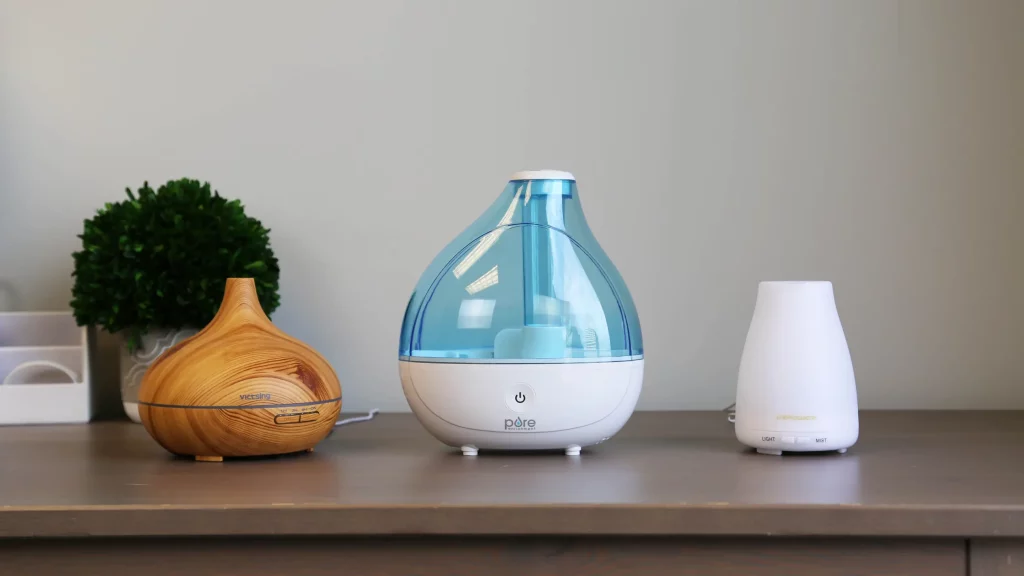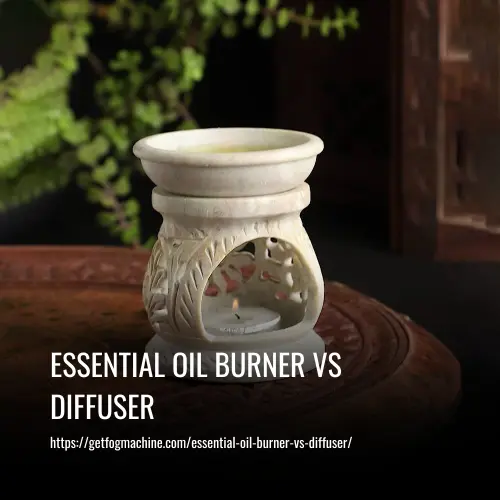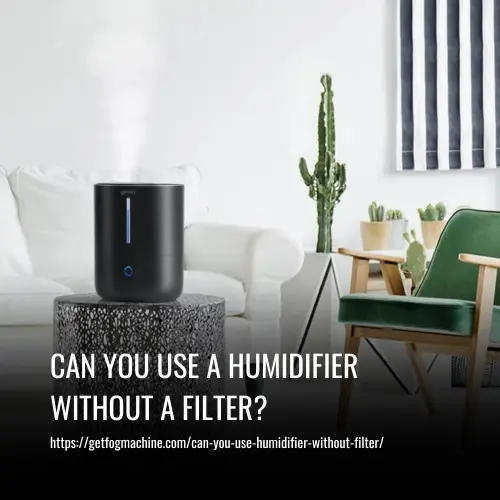Does Humidifier Make Room Warmer
This post contains affiliate links. As an Amazon Associate, we earn from qualifying purchases.
Yes, a humidifier can make a room feel warmer. This is because of the presence of moisture in the air, which helps to enhance the comfort level by carrying heat throughout the room. The increased humidity also reduces water evaporation from the human body, leading to less sweating and a warmer sensation.
Moreover, a humidifier keeps the skin and hair hydrated, resulting in a greater sense of warmth compared to a room without a humidifier.

What is a Humidifier
A humidifier is an appliance that adds moisture to the air in your home. It releases water vapor into the air to help maintain a comfortable and healthy indoor environment. There are different types of humidifiers available, such as evaporative, ultrasonic, impeller, and steam models. Each type has its own pros and cons depending on your specific needs.
Humidifiers can be beneficial for various reasons, including alleviating dry skin, reducing static electricity, and improving respiratory health. Choosing the right type of humidifier for your home depends on factors such as the size of the room and personal preference.
How Does a Humidifier Create Warmth in a Room
The use of a humidifier in a room can create warmth due to the release of moisture into the air. Both warm mist and cool mist humidifiers can contribute to this effect.
Warm Mist Humidifiers
Warm mist humidifiers are designed to release warm vapor into a room. They work by boiling water through a heating element, which then emits warm vapor. The heating element in these humidifiers also adds to the emission of heat into the room, further increasing the sensation of warmth.
Cool Mist Humidifiers
Contrary to what one might expect, cool mist humidifiers can also make a room feel warmer. These humidifiers work by moving water across a wick and pushing it out into a mist through a fan. Although the mist is cool, the increase in moisture content within the room causes the human body to retain internal moisture and prevent sweating. This retention of moisture leads to a warm sensation, regardless of the actual room temperature.
How Does a Humidifier Affect Temperature
When you use a humidifier, it adds water vapor into the air, increasing its relative humidity. This higher humidity level makes us more sensitive to heat, so even though the actual temperature remains the same, it will feel warmer. The moisture from the humidifier also improves air quality, as long as the device is properly maintained.
However, if not well-kept, it can cause the air quality to degrade and potentially lead to respiratory issues. In summary, a humidifier affects temperature perception by increasing the humidity level in the air, making it feel warmer to our bodies.
Room Temperature Vs. Water Vapor: Does This Factor Into Room Warmth?
When a humidifier releases water vapor into a room, it can contribute to an increase in the room’s temperature. This is because the process of convection occurs, where the increase in volume and mass from the water vapor invades the dry air already present in the room. This leads to an increase in friction viscosity, creating heat.
Additionally, as temperatures rise within the room, the water vapor’s capacity to expand also increases. This is known as relative humidity, and when water vapor responds to the ambient temperature, it can further contribute to the warmth of the room. Therefore, introducing water vapor into a warm room can indeed increase its temperature.
Factors That Impact The Temperature Change
The temperature change caused by a humidifier is influenced by several factors. The material of walls and furniture can affect how much warmth is felt. For instance, materials like wood and stone can absorb moisture, making them feel cooler. Conversely, lighter materials like plastic may retain more heat, making them feel warmer.
Additionally, the size of the room can impact the temperature change. Larger rooms with high ceilings take longer to heat up due to their greater volume and surface area. Considering these factors can help determine if a humidifier will effectively contribute to heating purposes.
Pros and Cons of Using a Humidifier to Heat a Room
Using a humidifier for heating purposes can offer several advantages. However, it is essential to consider potential drawbacks as well. Let’s delve into the pros and cons of using a humidifier to heat a room.
Advantages of Using a Humidifier for Heating
1. Cost-effective: Unlike electric space heaters or furnaces that consume electricity or gas, a humidifier for heating purposes does not require any additional energy source. All you need is tap water, making it a more cost-effective option.
2. Moisture balance: Humidifiers help maintain an optimal humidity level in the room. In dry winter months, when indoor humidity tends to drop, a humidifier can add moisture to the air, preventing dry skin, nasal passages, and sore throats.
3. Comfortable environment: Adding moisture to the air creates a more comfortable living space, especially during cold temperatures. It can help alleviate symptoms of dry air such as itchy skin, static electricity, and discomfort caused by excessively dry conditions.
Disadvantages of Using a Humidifier for Heating
1. Mold growth: Excessive humidity levels can lead to mold growth inside your home. It’s crucial to monitor and control the humidity using hygrometers regularly. Maintaining an appropriate level of humidity can help prevent mold issues.
2. Safety concerns and regulations: Depending on your location, certain types of humidifiers may be considered unsafe due to concerns such as hot water or heating elements. Before purchasing a humidifier, it is prudent to check local regulations regarding their use for heating purposes.
Tips for Using a Humidifier to Heat Your Room
Using a humidifier can effectively help heat a room while providing additional benefits for your health and comfort. Here are some tips to ensure optimal results:
1. Choosing the Right Size and Type of Humidifier
To effectively heat your room with a humidifier, it is crucial to select the right size and type of unit for your space. For larger rooms, such as living rooms or open-plan areas, consider using an evaporative or steam humidifier. These models are more powerful and can quickly add moisture to larger spaces.
If you have a smaller room, like a bedroom or office, an ultrasonic humidifier may be sufficient. These models are compact and energy-efficient, making them ideal for smaller areas. When choosing a humidifier, consider factors such as noise level and energy efficiency ratings to find the best fit for your needs.
2. Setting Up the Humidifier Correctly
Proper placement of your humidifier is essential for optimal performance. Place the unit near windows or vents to ensure that air circulates freely throughout the room, maintaining consistent humidity levels. Avoid placing the humidifier near walls or furniture that may obstruct airflow.
3. Monitoring and Maintaining Humidity Levels
Regularly check humidity levels in your room with an indoor hygrometer or a smartphone app designed for this purpose. Most experts recommend keeping relative humidity levels between 30-50%, depending on personal preference. If levels become too high, mold growth could become an issue. In this case, clean out any standing water in the humidifier’s tank/reservoir before continuing usage safely.

Alternatives to Using a Humidifier to Heat Your Room
Electric heaters are a practical alternative to using a humidifier to heat your room. These heaters offer efficient and cost-effective heating solutions, providing warmth quickly and easily. With various sizes, shapes, and styles available, you can find an electric heater that suits your needs perfectly.
Many models also come with adjustable thermostats for personalized comfort. Safety features, such as overheat protection or automatic shutoff, are often included as well. Another option is using space heaters, which utilize convection technology to circulate warm air throughout small spaces, like bedrooms or offices.
These heaters come in different sizes and designs, and adjustable thermostats allow for customized temperature settings. Both electric heaters and space heaters are effective alternatives that provide warmth without the need for a humidifier.
FAQs
No, warm mist humidifiers do not make the room warmer. They are designed to add moisture to the air without increasing its temperature. The heat generated by a warm mist humidifier is used solely for evaporating water and does not affect the ambient temperature of the room.
Yes, a humidifier can reduce cold symptoms. Adding moisture to the air, it helps relieve congestion and coughing. It also helps keep nasal passages moist, which can help reduce irritation from dry air. Additionally, keeping the indoor humidity level between 40-60% can help prevent viruses that cause colds from thriving in your home environment.
Yes, the electric motor in a humidifier does generate a small amount of heat. This is true for both cool mist and warm mist humidifiers. While the amount of heat generated is minimal, when combined with the added humidity from the humidifier, it can create a slightly warmer environment in the room.
Humidifiers add moisture to the air, and the interaction between humidity and heat can create a warmer feeling in the room. The temperature of the air before turning on the humidifier, along with the heat generated by the electrical appliance, contributes to this warmth. While the effect may not be significant, it can contribute to a more comfortable environment.
Conclusion
Using a humidifier can indeed make a room feel warmer. By increasing the level of humidity in the air, a humidifier can make the atmosphere feel more comfortable during cold winter months. This added moisture can help alleviate dry skin, sore throats, and static electricity caused by dry indoor air.
There are different types of humidifiers available, including warm mist, cool mist, and ultrasonic models. Warm mist humidifiers produce hot steam, which can effectively raise the moisture content in the air. On the other hand, cool mist humidifiers release water vapor into the room, creating a more refreshing atmosphere.
It is important to choose the right type of humidifier based on personal preferences and specific needs. Additionally, taking into consideration factors such as energy efficiency and potential mold growth is crucial when selecting a humidifier.






